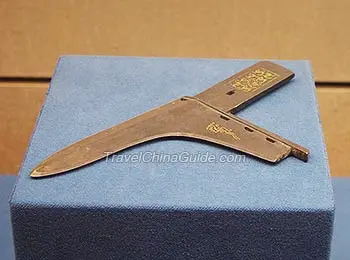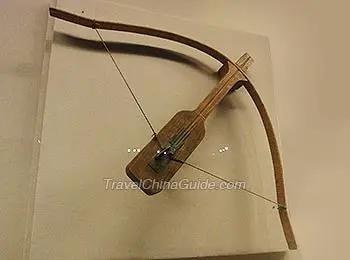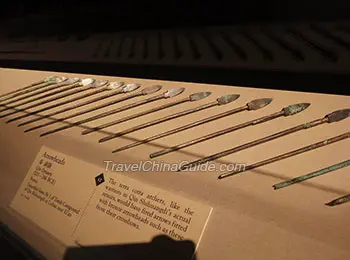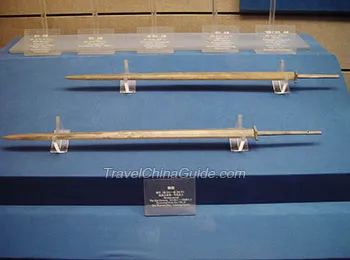In the 1970s, when people were examining the chemical composition of the Terracotta Army weapons, they were amazed to find the chromium compound on the weapons’ surface. Thus, some people speculated that 2,200 years ago, Qin people already cleverly knew how to use chromium to prevent the metals from rusting. However, this speculation was challenged by the archaeologists from Cambridge University and other institutions. According to their research, the chromium on the weapon’s surface is not an anti-rust agent used by Qin craftsmen, but merely a coincidence stained by the lacquer on the
Terracotta Army.
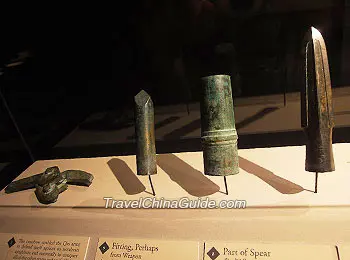 |
| Terracotta Army Weapons |
Discovery of Chromium Plate on Terracotta Army Weapons
In 1974, the Terracotta Army was accidently found. Along with the unearthed Terracotta Warriors, numerous Terracotta Army weapons also greatly drew people’s attention. These weapons were crossbows, swords, dagger-axes and arrows, mainly made of copper-tin alloy. As we know, metals made of copper or iron can easily get rusty. However, these unearthed copper weapons, which had been buried underground for more than 2,200 years, still remain intact! So, archaeologist’s curiosity was greatly aroused by Qin people’s anti-rust technique.
Many scholars suggested to first examine the chemical composition of the weapon. Through testing many intact copper swords, chromium was found on the weapons’ surface.
Speculation on Chromium Plate for Anti-rust Purpose
This chemical element reminded people of the Chromate Conversion Coating in modern metallurgical industry. This special coating can cut off the metal’s contact with oxygen, water and other acid substances, which considerably slows down the process of erosion. If this assumption was proved to be true, China mastered this anti-rust technique more than 2,200 years ahead of the rest of the world.
Suspicion of the Speculation
However, the speculation has no sound evidence. On the one hand, if an arrow was shot, it was hard to find it back. So it was pointless to paint it with an anti-rust coating. On the other hand, there are many records about the metallurgy in ancient China, and various anti-rust techniques were documented. How come there is no record about the use of chromium?
The Chromium Plate is just a Coincidence.
In order to figure it out, archaeologists from Cambridge University and other institutions decided to conduct a large-scale experiment on the Terracotta Army weapons and their surroundings. By virtue of the X-Ray Fluorescence (XRF), it was found that the chromium only existed in a small number of weapons. Among more than 460 examined weapons, only 8% contained chromium and the average content was only a little more than 0.1%.
Such selective use of chromium is contradictory to Qin people’s production standard. Moreover, the chromium was mainly found on the crossbow trigger, sword handle, sword sheath, and other accessories of the weapon. As for those crucial parts like sword blade and arrowhead, there was not a shred of chromium! More interestingly, other non-chromium weapons like copper sword and copper arrowhead were also well-preserved.
All these findings indicated that, firstly, Qin people had no idea about using chromium as anti-rust agent; secondly, other substances but not chromium played an important role in preserving Terracotta Army weapons. In short, the existence of chromium is just a coincidence.
Where did the chromium come from?
If Qin people didn’t use chromium on purpose, why was this chemical element found on the weapons’ surface? Archaeologists believed that the answer could only be hidden in the weapons’ surroundings. Through the interaction for more than 2,200 years, certain substance underground containing chromium was left over on the Terracotta Army weapons. So they tested the surroundings of the Terracotta Army:
1. Not Soil
Soil was undoubtedly the first thing to examine. Since the Terracotta Army is located in northwest China, where the soil has abundant FeCr204, some people considered the soil as the very resource of the chromium. However, the results showed that there was little chromium in the soil, and this chemical element was also impossible to move from the soil to the weapon. Therefore, this guess was demolished.
2. Not Paintings on the Terracotta Warriors
Painting was another possible resource of chromium. During the Warring States Period (475BC-221BC), Qin people would grind the colorful natural ores and then used them as paintings. And ores could contain chromium. However, this guess was also negated by the experimental results.
3. It is Lacquer on the Terracotta Warriors.
The third to be examined was the lacquer on the Terracotta Warriors. Before a Terracotta Warrior was painted with color, Qin craftsmen used to paint several layers of raw lacquer on it as a base. This raw lacquer was also painted on the spear’s wooden stick and the crossbow’s limb. That is to say, there is a large amount of raw lacquer in the pit of Terracotta Army. Qin people collected this substance from the trunk of lacquer tree. So this was normally a natural substance. However, it is recorded that sometimes ancient people would add some agents into the lacquer to improve its efficacy. Therefore, the researchers examined its composition. Surprisingly, the chromium content in the raw lacquer was considerably high and it turned out to be the resource of the chromium on the weapons. This result also helps explain why the arrow and crossbow had more chromium than other weapons did, because the former two firmly contacted with the lacquered wooden and bamboo materials.
What made Terracotta Army Weapons Anti-rust is Still Unknown.
All in all, the chromium on the Terracotta Army weapons is neither the anti-rust technique nor the Chinese ancient black technology, but simply the coincidence stained by the raw lacquer. However, here comes another question. If Qin craftsmen didn’t use chromium, how didn’t those weapons rust? Some people think it has a connection with the quenching technique. Others believe that it has resulted from the chemical element tin in bronzewares. But all these guesses are not proven, and Qin people’s anti-rust ingenuity is still veiled in secrecy.
- Last updated on Aug. 04, 2025 by Alex Jin -

